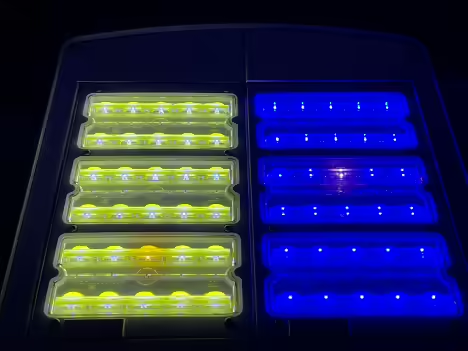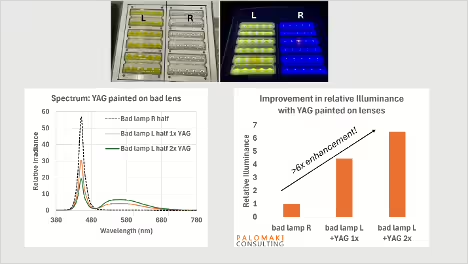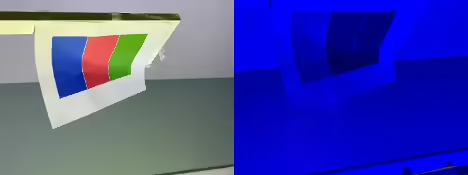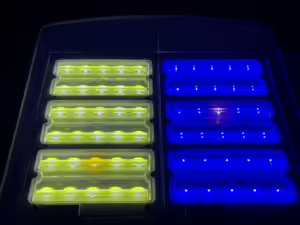It’s a phenomenon found frequently all around North America (maybe further?), regardless of climate. White LED streetlights are turning purple, blue, pink. It’s easy to see, not so easy to find out exactly what is happening. This is what we set out to do and explore a possible “quick fix” that takes no more skill than that possessed by a elementary school aspiring artist.

In my recent YouTube video collaboration with Matthew Bertram (below), we sourced two streetlights from Phoenix. One failing “purple” light, and a new one. It didn’t take long to find out the issue was with the phosphor layer on the LEDs delaminating or chipping off the underlying blue LEDs.
It seems the blue LEDs are still working just fine, but the phosphor that converts the blue light to a broad spectrum white light is what is failing. In the lamp we sourced, nearly all of the LEDs show some sign of failure, many with complete delamination such that only blue is being emitted from the LED. While these came from streetlights, it’s very reasonable that displays using similar LEDs could have the same problem.
The new style lamp that is replacing the failed ones across the country has different LEDs, with an encapsulant layer on top of the phosphor, presumably to help hold the phosphor layer in place. Time will tell if these LEDs will hold up better than the originals which were mostly installed around 2019 according to other reports.
It’s one thing to teardown a streetlight and discover what the issue is. But we wanted to see if we could “fix” it. At least get back to a reasonable color point that would not be offensive to the eye, and improve roadway and pedestrian safety. With a small sample of phosphor powder, and UV-curable ink, we coated a layer of phosphor on the outside of the lenses of one half of the broken lamp. In this way we can set up a nice experiment to determine exactly how much we can improve the useful white light output (illuminance) of the streetlight compared to the broken half. The results were staggering.

Spectral analysis showed a >6x enhancement in relative illuminance and a white point close to D65 white light once we coated the plastic lenses 2x with phosphor. Since our eyes are far more sensitive to white light compared to just blue, converting even some of the blue to white/yellow makes a big difference when it comes to the useful light output.

Additionally, the color rendering is vastly improved which can be simply observed by looking at a color swatch in blue-only light vs white light from the “fixed” side of the lamp. In the photo of the paper illuminated by the broken half of the lamp it appears gray scale. But when white light is used, the colors are clearly visible. It doesn’t take much effort to start to think of the safety implications here.

I use “fixed” loosely because we have not done any reliability testing on this approach, and it is likely to fail in some way shape or form. Our “fix” likely messes with the angular light output as well since we are adding a scattering component outside the lenses. Regardless, it demonstrates that, in a pinch, these failing purple/blue LED streetlights can be repaired to once again provide useful, white light. Of course warranty replacements are already happening, but I suspect there are more than a few places where this is not an option.
Have you seen purple streetlights in your town or city?
What about excess blue in your display?
Could the same failure mechanism be prevalent in displays with blue LED backlights too?

Peter Palomaki is the owner and chief scientist at Palomaki Consulting. He is widely recognized for his display teardown videos and scientific approach to helping clients. He utilizes his expertise in quantum dots and materials chemistry to solve challenging problems with clients large and small.

